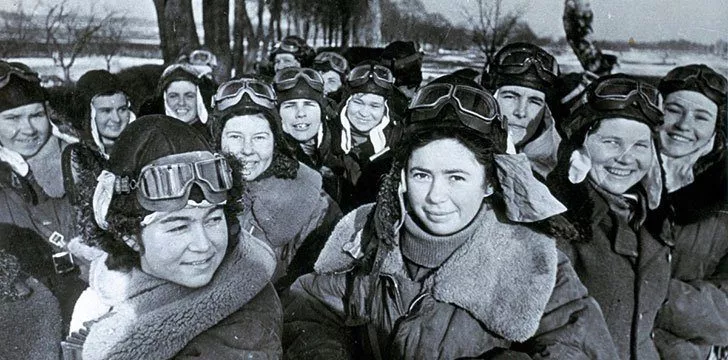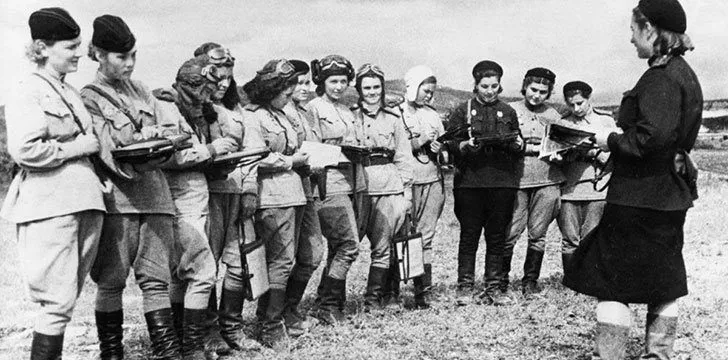The highly skilled pilots of the Soviet Union, known as the Night Witches, would turn off their engines as they approached their targets and glide towards them.
In 1941, Nazi Germany launched Operation Barbarossa and invaded the Soviet Union with 3.8 million troops, making their way almost to Moscow. However, the freezing winter weather stopped them in their tracks, giving the Soviet Army time to regroup and reorganize.
During this time, the Soviet Armed Forces mobilized 800,000 women, many of whom fought on the front lines. Stalin allowed women to take on second-line defense roles such as anti-aircraft gunners and medics to replace the high casualties suffered by male soldiers.
Women in the Soviet Armed Forces

Women were deployed in various roles such as medics, communication personnel, political officers, machine gunners, and tank drivers. Tatyana Kostyrina even commanded an infantry battalion and claimed 120 kills to her name. The most common combat deployment for women, however, was as snipers, with just under 2,500 female snipers active in the Red Army between 1941 and 1945.
Marina Raskova, a famous female aviator known as the “Russian Amelia Earhart,” established three regiments for female pilots in the Red Air Force. The 588th Night Bomber Regiment was the only all-female regiment, with female pilots, ground staff, and support staff. They were known as the Night Witches and decorated their planes with flowers, used navigation pencils as lipstick, and sewed underwear from silk parachutes taken from flares.
The 588th Night Bomber Regiment

The 588th Night Bomber Regiment was the most highly decorated female unit in the Soviet Air Force, consisting of 40 two-person crews at its largest. They flew over 23,000 sorties in total, dropping over 3,000 tons of bombs and 26,000 incendiary shells. They flew in old Polikarpov U-2 biplanes designed and manufactured in 1928 as training aircraft, which gave them a distinct advantage in their missions.
The biplane was slower than the German Messerschmitt Bf 109 and Focke-Wulf Fw 190’s stall speed. Despite this, the Night Witches, members of the 588th Night Bomber Regiment, could fly through enemy formations and were difficult for German pilots to shoot down. The Germans nicknamed them the Night Witches due to their attack technique of cutting their engines and gliding towards their target at low altitude. The only way to detect them was the sound of the wind through their canvas wings. The Night Witches were highly skilled and feared by German soldiers. They harassed many German units during the Red Army’s push out of their homeland. The 588th Night Bomber Regiment had 32 members killed in action, and 23 were awarded the Hero of the Soviet Union title. After the war, the regiment was disbanded, with some members returning to civilian life and others remaining in the Soviet Air Force. The Night Witches proved that women were equals on the battlefield and were a cunning and highly skilled unit.
FAQ
1. Who were the Soviet Night Witches?
The Soviet Night Witches were a group of female bomber pilots who served in the Soviet Air Force during World War II. They were given this nickname by their German enemies due to their stealthy night-time bombing raids.
2. How did the Soviet Night Witches come to be?
In 1941, the Soviet Union formed three all-female air force units in response to the German invasion. The women who signed up were trained as pilots, navigators, and mechanics, and were sent to the front lines to fight against the Germans.
3. What planes did the Soviet Night Witches fly?
The Soviet Night Witches flew Polikarpov Po-2 biplanes, which were outdated and made of plywood and canvas. These planes were slow and not very maneuverable, but they were lightweight and could fly at low altitudes, making them ideal for night-time bombing raids.
4. What were the Soviet Night Witches’ missions like?
The Soviet Night Witches flew night-time bombing missions, often with no radio or radar equipment. They would fly low over enemy targets, shutting off their engines and gliding towards their targets to avoid detection. They would then drop bombs on their targets before quickly flying away.
5. What kind of impact did the Soviet Night Witches have on the war?
The Soviet Night Witches played a crucial role in the war effort, flying over 30,000 missions and dropping over 23,000 tons of bombs. They were responsible for destroying enemy positions, supply lines, and communication centers, and their raids helped to slow down the German advance on the Eastern Front.
6. What kind of challenges did the Soviet Night Witches face?
The Soviet Night Witches faced numerous challenges, including harsh weather conditions, lack of proper equipment, and constant danger from enemy fire. They also faced sexism and discrimination from their male counterparts, who did not believe that women were capable of serving in combat roles.
7. What kind of recognition did the Soviet Night Witches receive?
Despite their bravery and accomplishments, the Soviet Night Witches received little recognition during the war. It was not until after the war that they began to receive medals and other honors for their service.
8. What is the legacy of the Soviet Night Witches?
The Soviet Night Witches are remembered as trailblazers who defied gender stereotypes and made significant contributions to the war effort. They continue to inspire women in aviation and the military to this day.

Zayn Anderson is a prolific writer with a passion for uncovering the world’s intriguing facts. Armed with an insatiable curiosity, he delves into various subjects, from history and science to nature and technology.
